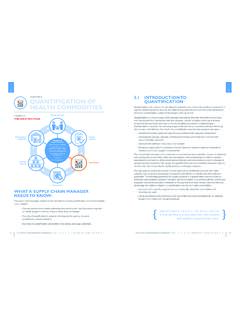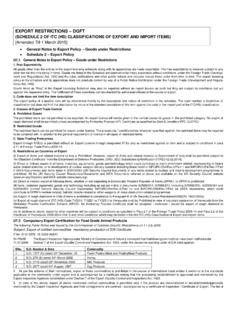Transcription of CHAPTER 8 WAREHOUSING AND DISTRIBUTION
1 THE SUPPLY CHAIN MANAGER S HANDBOOK A PRACTICAL GUIDE TO THE MANAGEMENT OF HEALTH COMMODITIESTHE SUPPLY CHAIN MANAGER S HANDBOOK A PRACTICAL GUIDE TO THE MANAGEMENT OF HEALTH COMMODITIES88 WAREHOUSING AND DISTRIBUTIONCHAPTER 8 WHAT A SUPPLY CHAIN MANAGER NEEDS TO KNOW: WAREHOUSING and DISTRIBUTION are the two supply chain activities that often require the largest proportion of a supply chain operation s budgets. When a supply chain manager has well-functioning WAREHOUSING and DISTRIBUTION management systems, he or she can extend the working life of public health infrastructure, reduce the overall costs of transport, and improve the provision of public health supply chain manager needs to know the following about WAREHOUSING and DISTRIBUTION , which are covered in this CHAPTER .
2 How to carry out the key WAREHOUSING activities of receiving, storage and shipping How to plan warehouse space requirements and warehouse layout The key components of inventory management Issues to consider in positioning warehouse assets to optimize storage and DISTRIBUTION Issues to consider in designing the transportation network and managing the transportation WAREHOUSING It is important that supply chain managers have an overall strategy for commodity WAREHOUSING , particularly in resource poor environments where WAREHOUSING can provide a buffer against uncertainties and breakdowns within the supply chain.
3 Managers need to think of warehouses not simply as four walls, a ceiling and a floor where inventory rests, but as dynamic operations centers housing a varied range of distinct yet complementary activities that combine to collect and hold products for subsequent shipment to service delivery points. Products are warehoused at every facility in the pipeline. Good WAREHOUSING ensures the physical integrity and safety of products and their packaging throughout the various storage facilities until they are dispensed to clients. The various activities that occur within a warehouse should be aligned so that products can be managed efficiently and orders can be filled and distributed expeditiously.
4 Requirements for good WAREHOUSING practices include: 1 A facility with adequate storage and working space as well as infrastructure components that will protect commodities from harmful environmental conditions 2 Application of proper procedures so that commodities are always available, accessible, in good condition, and pose no risk of injury to workers 3 Availability of timely and accurate inventory data for decision-making 4 Qualified human resources in sufficient quantity to meet operational needs Regardless of storage facility size from a small health center to a central warehouse the main operational activities for storage are very similar.
5 How complex these activities become varies based on the volume of products to be managed and storage facility size; as well as particular product handling requirements, such as cold storage. KEY WAREHOUSING MATERIAL RECEIVING AND INCOMING INSPECTIONThis activity occurs during the unloading of inbound vehicles and includes the visual inspection of delivered packages to ensure that products were not damaged during transport. It is also important during this activity that staff verify the quantities of products received against the packing slip or shipping invoice and report any discrepancies. FIGURE 8-1.
6 THE LOGISTICS CYCLES erving CustomersInventoryStrategyQuantification WAREHOUSING & DistributionProcurementTHE LOGISTICS CYCLEP roduct SelectionManagement Support FunctionsSystem Design & StrategyLogistics Management Information Systems (LMIS)Performance ManagementOrganizational Capacity and WorkforceFinancingRisk Management109110 THE SUPPLY CHAIN MANAGER S HANDBOOK A PRACTICAL GUIDE TO THE MANAGEMENT OF HEALTH COMMODITIESTHE SUPPLY CHAIN MANAGER S HANDBOOK A PRACTICAL GUIDE TO THE MANAGEMENT OF HEALTH COMMODITIES88 Shelf life is the length of time from the manufacturing date that a product can be safely and effectively used assuming it is stored according to the manufacturer s specifications.
7 All pharmaceuticals have a shelf life specified by the manufacturer and that shelf life is validated by the national drug regulatory authority when the product is registered in-country. Shelf life can range from several months to several years depending on the product. After a product s shelf life has expired, its usability, purity, and/or potency may be adversely affected. For some medicines, the expiration date also affects the safety of the product. As a safety precaution, the expiration date should be considered the last date the customer should use the medicine. Expired products need to be segregated from usable products and be properly disposed.
8 All medicines should be managed according to a first-expiry, first out policy to avoid potential expiry and PUT AWAYThis process includes moving products from the unloading dock, or receiving area, after they are released for storage; and assigning them to their designated storage area (rack, shelf, floor, etc.). It is important that every product moved into or out of the racks, shelves, or any storage area is correctly recorded on the stockkeeping GUIDELINESA nnex 8-1 provides detailed storage guidelines that should be followed, regardless of the size of the facility. Though some of these rules may be adapted based on the facility, others should always be applied.
9 For example, it is unreasonable to expect a small health center to have more than a small closet or cupboard for storing medical supplies. Using pallets in such a small space would be inappropriate. Small shelves that keep products away from exterior walls and off the floor may be sufficient. Conversely, cartons should always be stacked with the arrows pointing up regardless of the type of facility. It is also helpful to bear in mind that although some budget and resources are necessary to adhere to these guidelines, others, such as the example with stacking cartons correctly, can be followed by all staff at all facilities without requiring additional VISUAL INSPECTIONThe quality of storage conditions may vary along the supply chain and a manager may occasionally need to verify the quality of some products.
10 Visual inspection is the process of examining products and their packaging to look for obvious problems with product appropriate storage conditions and ensuring that damaged or expired products do not reach a service delivery point where they could be inadvertently given to a client is essential. To ensure the quality of the product in your warehouse and pipeline, conduct a visual inspection when you do any of the following: Receive products from the manufacturer (usually at the central level) Conduct a physical inventory count Receive a complaint about a product you issued Identify a product that is about to expire Identify a damaged product Notice that a product has not been stored basic types of damage may occur during shipping and storage that affect product quality: mechanical and chemical.








